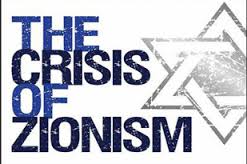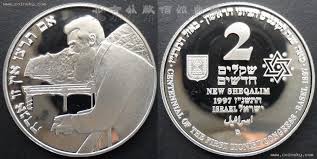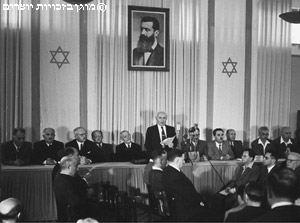



錫安主義(希伯來語:ציונות【讀:Tsiyonut】,阿拉伯語:الصهيونية【讀:al-Sahyūnī】),也稱「猶太聖會主義」,中國大陸官方習慣(擇其用意)譯為「猶太復國主義」,是猶太人發起的一種民族主義政治運動和猶太文化模式,旨在支持或認同於以色列地帶重建「猶太家園」的行為,也是建基於猶太人在宗教思想與傳統上對以色列土地之聯繫的一種意識形態。
猶太人是一個源自古代近東地區以色列居民的民族[1]。有人類學研究認為時間公元前10世紀或公元9世紀該地區的鐵器時代曾經存在過猶太部落王國[2]。根據猶太教、基督教和伊斯蘭教教義,以色列地帶為猶太人的應許之地。
在猶太復國運動發展初期,錫安主義是世俗化的,也是一定程度上對19世紀時在歐洲和以阿拉伯世界為首的穆斯林社會中十分猖獗的反猶主義的一種回應。在經過一連串的進展和挫折,以及在納粹德國對猶太人大屠殺中摧毀了歐洲的猶太族群後,錫安主義的民粹運動於1948年(尤其是以色列立國前後)達到了高潮
Zionism (Hebrew: צִיּוֹנוּת, translit. Tsiyonut) is a nationalist movement of Jews and Jewish culture that supports the creation of a Jewish homeland in the territory defined as the Land of Israel.[] A religious variety of Zionism supports Jews upholding their Jewish identity, opposes the assimilation of Jews into other societies and has advocated the return of Jews to Israel as a means for Jews to be a majority in their own nation, and to be liberated from antisemitic discrimination, exclusion, and persecution that had historically occurred in the diaspora.1] Zionism emerged in the late 19th century in central and eastern Europe as a national revival movement, and soon after this most leaders of the movement associated the main goal with creating the desired state in Palestine, then an area controlled by the Ottoman Empire.[2][3][4] Since the establishment of the State of Israel, the Zionist movement continues primarily to advocate on behalf of the Jewish state and address threats to its continued existence and security.[citation needed] In a less common usage, the term may also refer to non-political, cultural Zionism, founded and represented most prominently by Ahad Ha'am; and political support for the State of Israel by non-Jews, as in Christian Zionism.
「錫安主義」來自「錫安」(希伯來語:ציון,讀:Tzi-yon)一詞,也就是位於耶路撒冷附近的錫安山,有代指「耶路撒冷」之意。在舊約聖經裏,章節《撒母耳記下 5:7》提到:「錫安的堡壘,大衛的城」(fortress of Zion, city of David)。在大衛王的統治下,「錫安」一詞成為「耶路撒冷」和「以色列之地」的代名詞。在聖經的各種版本中,以色列人或猶太人多被通稱為「錫安之子(女)」或「錫安的人民」。
發動現代猶太復國主義的一個關鍵事件是1894年發生在法國的德雷福斯事件。 猶太人被這起在他們認為是自由與啟蒙的發源地的國家發生的反猶太主義事件深深地震動了。這個事件的一個見證者是猶太裔奧地利人西奧多·赫茨爾。在1896年他出版的一個叫做《猶太國》的小冊子中,他將這個事件描述成一個轉折點——在德雷福斯事件以前,赫茨爾曾經是一個反猶太復國主義者;在事件以後他變成了一個猶太復國主義的熱烈追隨者。然而,歷史學家們一直沒有重視赫茨爾的自述,轉而指出推動現代猶太復國主義普及的主要因素是煽動政治家卡爾·魯埃格所持有的反猶太人主義觀點的流行化。[5] 1897年,赫茨爾在瑞士的巴塞爾召開了第一次猶太復國主義者大會。這次大會成立了世界猶太復國主義者組織(WZO),通過了錫安主義的綱領性文件《巴塞爾計劃》,並推選赫茨爾為這個組織的第一任主席。
1947年英國宣布了他們從巴勒斯坦撤出的願望,然後在同年的11月29日,聯合國大會投票通過了一項將巴勒斯坦分割成一個阿拉伯國家和一個猶太國的議案(耶路撒冷成為國際領土)。在巴勒斯坦的阿拉伯人和猶太人之間馬上爆發了內戰。1948年5月14日巴勒斯坦的猶太人領導人宣布獨立,從而建立了以色列國。這在猶太復國主義運動歷史中標誌著一個重要的轉折點,因為運動的主要目標已經達成了。許多猶太復國主義組織採用了新方針,而那三個軍事組織也組合而成了以色列國防軍。
Nationalist Zionism originated from the Revisionist Zionists led by Jabotinsky. The Revisionists left the World Zionist Organization in 1935 because it refused to state that the creation of a Jewish state was an objective of Zionism. The revisionists advocated the formation of a Jewish Army in Palestine to force the Arab population to accept mass Jewish migration. Revisionist Zionism evolved into the Likud Party in Israel, which has dominated most governments since 1977. It advocates that Israel maintain control of the West Bank, including East Jerusalem, and takes a hard-line approach in the Israeli-Arab conflict. In 2005 the Likud split over the issue of creation of a Palestinian state on the occupied territories, and party members advocating peace talks helped form the Kadima party.
1918年鄂圖曼帝國瓦解,巴勒斯坦不再受制,猶太復國運動進入嶄新的局面。首先擴大在巴勒斯坦的猶太屯墾區,開始國家公共基礎建設和籌募建設基金,並且勸阻或迫使英國當局不可採取任何將導致巴勒斯坦地區成為阿拉伯人佔多數的動作。1920年代猶太人口穩定成長,猶太建制亦具國家雛形,但同時巴勒斯坦阿拉伯民族主義的興起,對猶太人移入的抵制升高。
- 1樓. hsr2014/07/30 14:12
- 猶太民族的團結、與歷史上故土的羈絆、以及以色列及其首都耶路撒冷作為該國生活之核心。
- 從所有國家移入以色列,以及所有移民有效融入以色列社會。
- 將以色列強化為一猶太的、錫安主義的及民主的國家,並將其形塑為一個帶有相互尊重多元猶太民族的,及根植於先知預言之獨特道德及精神特質的模範社會。致力於達成和平,並為構築更美好的世界做出貢獻。
- 透過深化猶太、希伯來及錫安主義教育,確保猶太民族之未來及獨特性,強化精神及文化價值,並教導希伯來語為國語。
- 培養相互的猶太責任,捍衛猶太人作為個人及民族的權利,代表猶太民族錫安主義利益,並為抵抗展現反猶太主義之活動而奮鬥。
- 將國家設定為是錫安主義的具體表現。







